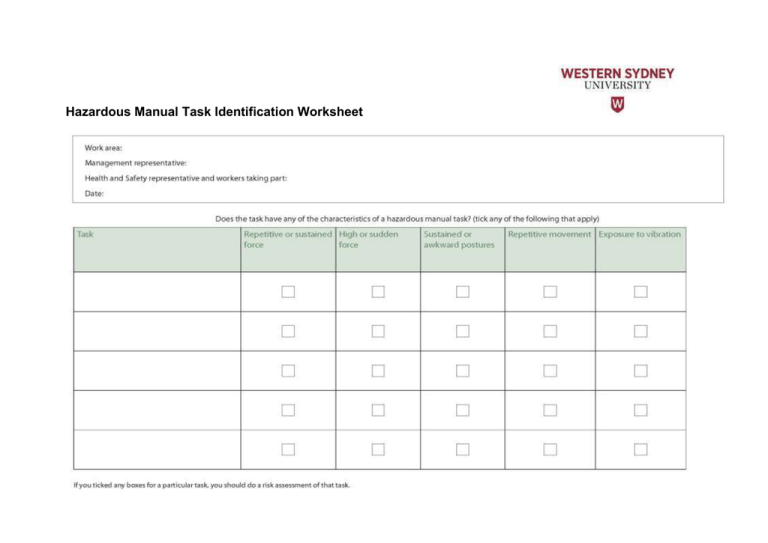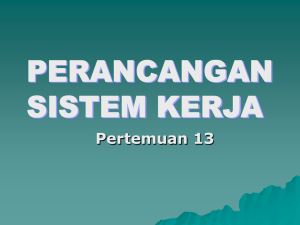Hazardous Manual Task Identification Worksheet Owner: WHS Unit Revised: October 2012
advertisement

Hazardous Manual Task Identification Worksheet Owner: WHS Unit Revised: October 2012 1 Owner: WHS Unit Revised: October 2012 1 The Characteristics of Hazardous Manual Tasks to consider include the following: Force is the amount of muscular effort required to perform a movement or task. Forceful muscular exertions overload muscles, tendons, joints and discs and are associated with most MSDs. Repetitive force using force repeatedly over a period of time to move or support an object Examples of repetitive force include: Sustained force occurs when force is applied continually over a period of time. High force occurs in any tasks that: a worker describes as very demanding physically a worker needs help to do because of the effort it requires require a stronger person or two persons to do the task. Owner: WHS Unit Revised: October 2012 Figure 1 Examples of sustained force include: High force – may be exerted by the back, arm or leg muscles or by the hands and fingers. lifting and stacking goods onto a pallet gripping and handling bricks when bricklaying (Figure 1) repetitively pressing components with the thumbs or other part of the hand to assemble an item prolonged application of therapeutic massage treatments removing splinting material from patients using shears. pushing or pulling a trolley around hospital wards (Figure 2) holding down a trigger to operate a power tool supporting a plaster sheet while fixing it to a ceiling carrying objects over long distances supporting, positioning or stabilising a patient’s limb during surgery or when applying splinting or casting material Figure 2 Examples of high force include: Lifting, lowering or carrying a heavy object Lifting, lowering or carrying an object that cannot be positioned close to the body pushing or pulling an object that is hard to move or stop restraining a person or animal.(Figure 3) Figure 3 Examples of high force using the hands and fingers include: using a finger-grip, a pinch-grip or an open-handed grip to handle a heavy or large load operating hand tools with tight squeeze grips(Figure 4) gripping small instruments with high force, for example, a dental hygienist cleaning teeth. Figure 4 Sudden force – jerky or unexpected movements while handling an item or load are particularly hazardous because the body must suddenly adapt to the changing force. Tasks where force is applied suddenly and with speed also generates high force. Examples of sudden force include: impact recoil of a large nail gun throwing or catching objects cutting reinforcement steel with large bolt cutters carrying an unbalanced or unstable load such as bagged stock feed pellets that suddenly moves (Figure 5) handling frightened or resistant animals handling patients who suddenly resist or no longer assist during the handling procedure. Figure 5 Movement Repetitive movement – using the same parts of the body to repeat similar movements over a period of time. Examples of repetitive movement include: Owner: WHS Unit Revised: October 2012 painting lifting goods from a conveyor belt and packing them in a carton typing and other keyboard tasks(Figure 6) repeatedly reaching for and assembling components in electronics manufacturing using a socket and ratchet or spanner to unscrew long bolts. Figure 6 Owner: WHS Unit Revised: October 2012 Posture An ideal posture is one where the trunk and head are upright and forward facing, the arms are by the side of the body, the forearms are either hanging straight or at right angles to the upper arm, and the hand is in the handshake position. Postures that are both awkward and sustained are particularly hazardous. Sustained posture – where part of or the whole body is kept in the same position for a prolonged period. Examples of sustained posture include: supporting plasterboard sheeting while it is nailed into place (Figure 7) continually standing with weight mainly on one leg while operating a power press with foot pedal controls. Figure 7 Awkward posture – where any part of the body is in an uncomfortable or unnatural position, such as: postures that are unbalanced or asymmetrical postures that require extreme joint angles or bending and twisting. Owner: WHS Unit Revised: October 2012 Examples of awkward posture include: squatting while servicing plant or a vehicle working with arms overhead bending over a desk or table using a hand tool that causes the wrist to be bent to the side kneeling while trowelling concrete or laying carpet bending the neck or back to the side to see around bulky items pushed on a trolley. (Figure 8) Figure 8 Vibration There are two common forms of vibration according to contact points between the body and the source: Whole body vibration occurs when vibration is transmitted through the whole body, usually via a supporting surface, such as a seat or the floor in heavy vehicles or machinery. This may result in lower back pain, degeneration of the lumbar vertebrae and disc herniation. Examples of whole body vibration include: Hand-arm vibration occurs when vibration is transferred through a vibrating tool, steering wheel or controls in heavy machinery to the hand and arm. This can disrupt blood circulation in the hand and forearm and damage nerves and tendons. Localised vibration contributes to ‘vibration-induced white finger’ and ‘carpal tunnel syndrome’ through the gripping force needed to hold the vibrating tools (the tighter the grip, the more vibration is absorbed) and the repetitive shock loads of some tools. Examples of hand-arm vibration include: Owner: WHS Unit Revised: October 2012 operating mobile plant such as heavy earth moving machinery driving a vehicle over rough terrain.(Figure 9) Figure 9 using impact wrenches, chainsaws, jackhammers, grinders, drills or vibrating compacting plates (Figure10-11) using needle guns in de-rusting metal. Figure 10-11

